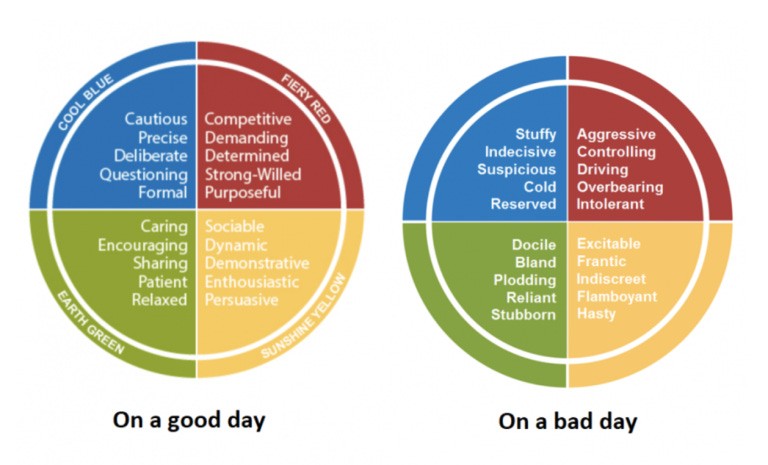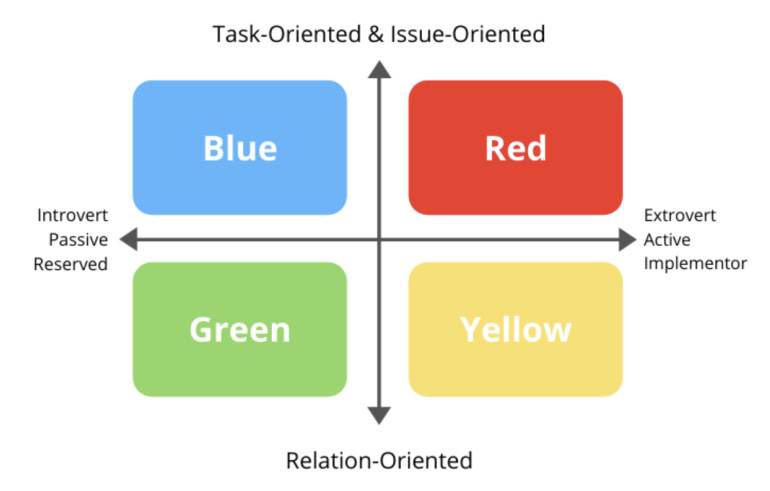Hand up, if you work with idiots.
I see one hand, two hands, three hands, …
It’s not nice to say that about others. But we don’t understand each other. With digitalization, corporate jargon, and a lack of listening/attention we pay to one another, we’re losing it.
We don’t bother to understand with whom we’re working. It is easy to say “you’re an idiot” instead of “Wait a sec, you’re just different to me.”
Thomas Erikson wrote a book about it, and here are my four takes you should realize today.
1. Different people work differently
Nothing new under the Sun.
But if you bother to acknowledge the differences and analyze with whom you work. You may realize there are four types: blue, red, green, and yellow.
Here are our lovely colleagues:
Some people are naturally more demanding and determined than others. You may work with analytical types (blue) or someone who hates conflicts (green). You like hanging out with sociable and funny coworkers (yellow).
The point is to accept the differences.
You want to work with a variety of people; that is how you compensate for each other’s weaknesses. Since no color is the best one.
Get rid of black and white tunnel vision and dare to hire someone completely different from you. You will be doing yourself a big favor.
2. A good team has them all
A working team has “every” color. Because you need ideas (yellow), decisions (red), quality evaluation (blue), and someone to keep it all together (green).
Some color combinations naturally work well together. E.g., task-oriented blue and red, green (execute the plan), and yellow (come up with the plan) for their ability to provide what the other needs.
Another good combination is blue and green, since they both work at a gentle pace and think things through. Likewise, red and yellow can work since their both action-driven. They get things done quickly. Yellow comes up with a plan, and red makes decisions to put it into action.
Still, in real teams, you have people who are partially blue and partially green, people who are red and blue, and all other different combinations. Only 5% of people, according to Thomas Erikson, are one color. The 85% is 2 dominant colors, and the rest have 3 or more.
So, the take is to make sure you have all the different people included in your team. People are oriented to tasks as well as to relationships.
By working with people, you can quickly assess which color they have in which situation. Then, pair them accordingly, and you can avoid unnecessary feedback and conflicts.
3. Teach others to ask for feedback; otherwise, it won’t work
I found the chapter about feedback especially intriguing. Erikson gives ideas on how to deliver feedback, but at the same time, he points out that red and yellow don’t listen to or acknowledge the feedback.
Green hates being criticized and positions himself as the victim, and says, “I will never do it again,” while in reality, nothing changes.
Blue will try to twist feedback on you by showing you don’t have enough details, and therefore, he knows better than you.
So, all in all, feedback is pointless since no one listens to it, and it damages relationships. The question, rather, is how to work together without bothering with feedback. Everyone takes it personally.
So, save yourself time, skip feedback, and work with each strengths instead of weaknesses.
Teach people to ask for feedback. That is the best way to avoid hurt feelings and hijacked emotions.
If you want it, you show interest, self-awareness, and a growth mindset. Then, feedback works.
4. Don’t obsess over colors
The typology is a great way to understand the people around you. Still, don’t use it like a mantra.
It is one way to look at it. Then, you have many moments in which people react unpredictably. So, don’t be too quick to evaluate people.
I’ve caught some managers some time ago thinking like this:
“He’s a typical red. A selfish, intolerant mate, I will never get along with.”
Judging others is always easier than looking in the mirror.
Do it from time to time.
Aren’t you an Idiot?!
Read the book
TL;DR
Learn to like different colors. You don’t have to be friends with everyone. But why not work like professionals?
All you need to do is let go of your ego and focus on the mission at hand. Every one of your team members can help a great deal with it.
Have a good one, Ivona







